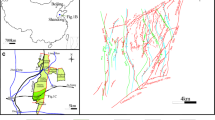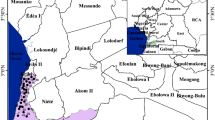Abstract
The water-conducting fractured zone induced by mining under aquifers is channels for water and sand inrushes. A method based on multiple regression analysis and a geographic information system (GIS) is proposed to predict the height of the water-conducting fractured zone in this paper. Five main indicators are found to control the height of the water-conducting fractured zone during fully mechanized caving mining under aquifers in which the thickness of the coal seam is more than 3 m: thickness of the coal seam, proportion of hard rock, length of the panel, mined depth and dip angle. The height of water-conducting fractured zone and the predictive variables from eighteen coal mines in China are investigated. Based on information entropy theory, a nonlinear multiple regression model and the weight of the indicators are considered, and the nonlinear multiple regression model is used in the GIS. Then, the approach is validated with a case study of the Xiegou Coalmine in the Shanxi province of China, in which the thickness of the coal seam which is under aquifers is more than 3 m. Error analysis of the approach is calculated with different hydrogeology classification. The results indicate that this model is a useful tool for predicting and analyzing the height of the water-conducting fractured zone, since the height of the water-conducting fractured zone can be quantitatively calculated and visualized.










Similar content being viewed by others
References
Baalousha H (2010) Assessment of a groundwater quality monitoring network using vulnerability mapping and geostatistics: a case study from Heretaunga Plains, New Zealand. Agric Water Manag 97(2):240–246
Cao DT, Li WP (2014) Estimation method for height of fractured zone with water flow in coal mining area. Chin J Geol Hazard Control 25(1):63–69 (in Chinese)
Chen LW, Zhang SL, Gui HR (2014) Prevention of water and quicksand inrush during extracting contiguous coal seams under the lowermost aquifer in the unconsolidated Cenozoic alluvium—a case study. Arab J Geosci 7(6):2139–2149
Chen LW, Feng XQ, Xie WP, Zeng W, Zheng ZY (2017) Using a fluid–solid coupled numerical simulation to determine a suitable size for barrier pillars when mining shallow coal seams beneath an unconsolidated, confined aquifer. Mine Water Environ 36(1):67–77
Connolly J, Holden NM, Ward SM (2007) Mapping peatlands in Ireland using a rule-based methodology and digital data. Soil Sci Soc Am J 71(2):492–499
Du F, Gao R (2017) Development patterns of fractured water-conducting zones in longwall mining of thick coal seams—a case study on safe mining under the Zhuozhang River. Energies 10(11):1856
Fan GW, Zhou L (2010) Mining-induced variation in water levels in unconsolidated aquifers and mechanisms of water preservation in mines. Min Sci Technol (China) 20(6):814–819
Feng SJ, Sun SG, Lv YG, Lv J (2011) Research on the height of water flowing fractured zone of fully mechanized caving mining in extra-thick coal seam. Procedia Eng 26:466–471
Hu XJ, Li WP, Cao DT, Li MC (2012) Index of multiple factors and expected height of fully mechanized water flowing fractured zone. J China Coal Soc 37(4):613–620 (in Chinese)
Huang QM, Wu B (2018) Evolution of the fractured zone above a coal face with a large mining height: a case study of the Dahuangshan Coalmine, China. Geotech Geol Eng 36:1–13
Huang WP, Li C, Zhang LW, Yuan Q, Zheng YS, Liu Y (2018) In situ identification of water-permeable fractured zone in overlying composite strata. Int J Rock Mech Min Sci 105:85–97
Jenks GF (1963) Generalization in statistical mapping. Ann Assoc Am Geogr 53(1):15–26. https://doi.org/10.1002/9780470979587.ch30
Kratzsch H (2012) Mining subsidence engineering. Springer Science and Business Media, New York
Krige DG (1981) Lognormal-de Wijsian geostatistics for ore evaluation. South African Institute of mining and metallurgy, Johannesburg, p 51
Li YJ, Li C, Sun H, Xu HT (2015) Research on upper limit increased of mining in coal mining face. Applied mechanics and materials, vol 737. Trans Tech Publications, Switzerland, pp 846–850
Liu XS, Tan YL, Nin JG, Tian CL, Wang J (2015) The height of water-conducting fractured zones in longwall mining of shallow coal seams. Geotech Geol Eng 33(3):693–700
Liu SL, Li WP, Wang QQ, Pei YB (2018) Investigation on mining-induced fractured zone height developed in different layers above Jurassic coal seam in western China. Arab J Geosci 11(2):30
Miao XX, Cui XM, Wang JA, Xu JL (2011) The height of fractured water-conducting zone in undermined rock strata. Eng Geol 120(1–4):32–39
Núñez JA, Cincotta PM, Wachlin FC (1996) Information entropy: An indicator of chaos. Chaos in gravitational N-body systems (La Plata, 1995). Celest Mech Dyn Astr 64(1–2):43–53
Palchik V (2003) Formation of fractured zones in overburden due to longwall mining. Environ Geol 44(1):28–38
Peng SS, Ma WM, Zhong WL (1992) Surface subsidence engineering. Society for Mining, Metallurgy, and Exploration, Baltimore
State Administration of Work Safety (2009) Regulations of Preventing Water Hazards for Coalmines. Coal Industry Press, Beijing (in Chinese)
State Bureau of Coal Industry (2000) Regulations of coal mining and protective coal pillar design under buildings, water bodies, railways, coal mines and roadways. Coal Industry Press, Beijing (in Chinese)
Su BY, Yue JH (2017) Research of the electrical anisotropic characteristics of water conductive fracture zones in coal seams. Appl Geophys 14(2):216–224
Su BY, Malekian R, Yu JC, Feng XH, Liu ZX (2016) Electrical anisotropic response of water conducted fractured zone in the mining goaf. IEEE Access 4:6216–6224
Turchaninov IA, Iofis MA, Kasparyan EV (1979) Principles of rock mechanics. Nedra, Leningrad
Wang JA, Park HD (2003) Coal mining above a confined aquifer. Int J Rock Mech Min Sci 40(4):537–551
Wang FT, Tu SH, Zhang C, Zhang YW, Bai QS (2016) Evolution mechanism of water-flowing zones and control technology for longwall mining in shallow coal seams beneath gully topography. Environ Earth Sci 75(19):1309
Wang G, Wu MM, Wang R, Xu H, Song X (2017) Height of the mining-induced fractured zone above a coal face. Eng Geol 216:140–152
Yang BB, Sui WH (2012) A fuzzy comprehensive evaluation of coal mining near unconsolidated aquifers. Coal Geol Explor 40(4):43–51
Yang WM, Li LC, Li XJ, Wang LG (2014) Water outbursts in underground mining with steeply dipping coal seams: numerical simulations based on a mining case. Eur J Environ Civil Eng 18(5):511–535
Yang BB, Sui WH, Duan LH (2017a) Risk Assessment of water inrush in an underground coal mine based on GIS and fuzzy set theory. Mine Water Environ 36(4):617–627
Yang BB, Sui WH, Duan LH (2017b) Risk assessment of water inrush in an underground coal mine based on gis and fuzzy set theory. Mine Water Environ 36:617–627 (in Chinese)
Zhang ST, Liu Y (2012) A simple and efficient way to detect the mining induced water-conducting fractured zone in overlying strata. Energy Procedia 16:70–75
Zhang J, Shen B (2004) Coal mining under aquifers in China: a case study. Int J Rock Mech Min Sci 41(4):629–639
Zhang JX, Jiang HQ, Deng XJ, Ju F (2014) Prediction of the height of the water-conducting zone above the mined panel in solid backfill mining. Mine Water Environ 33(4):317–326
Zhang S, Tang SJ, Zhang DS, Fan GW, Wang Z (2017) Determination of the height of the water-conducting fractured zone in difficult geological structures: a case study in Zhao Gu No. 1 coal seam. Sustainability 9(7):1077
Zhou DW, Wu K, Li L, Yu JW (2016) Impact of thick alluvial soil on a fractured water-conducting zone: an example from Huainan coal mine, China. J South Afr Inst Min Metall 116(5):431–440
Acknowledgements
The authors would like to acknowledge financial support from the National Key R&D Program of China under Grant No. 2017YFC0804101. We would also like to thank the Shanxi Xishan Jinxing Energy Corporation Ltd. for providing data support.
Author information
Authors and Affiliations
Corresponding authors
Additional information
Publisher's Note
Springer Nature remains neutral with regard to jurisdictional claims in published maps and institutional affiliations.
Rights and permissions
About this article
Cite this article
Liu, Y., Yuan, S., Yang, B. et al. Predicting the height of the water-conducting fractured zone using multiple regression analysis and GIS. Environ Earth Sci 78, 422 (2019). https://doi.org/10.1007/s12665-019-8429-3
Received:
Accepted:
Published:
DOI: https://doi.org/10.1007/s12665-019-8429-3




